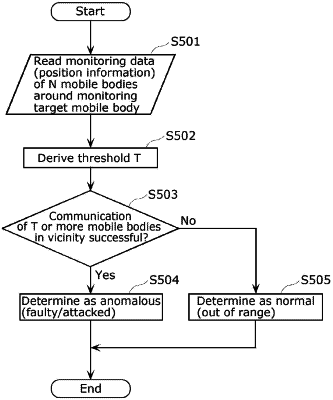| CPC H04L 43/10 (2013.01) [H04W 8/22 (2013.01); H04L 63/107 (2013.01); H04W 4/40 (2018.02); H04W 4/46 (2018.02)] | 10 Claims |

|
1. An information processing device, comprising:
a transceiver that communicates with a first mobile body;
a monitoring data storage that stores past monitoring data of the first mobile body received by the transceiver;
a processor and a memory which stores an instruction, wherein when the processor executes the instruction stored in the memory, the processor operates as an alive monitor that determines whether a current state of the first mobile body is anomalous, based on the past monitoring data stored in the monitoring data storage, wherein the alive monitor determines whether the current state of the first mobile body is anomalous using the past monitoring data stored in the monitoring data storage, when the transceiver does not receive at least one of latest monitoring data or a heartbeat signal from the first mobile body; and
a determination information storage that stores a threshold for a total number of mobile bodies to determine whether the first mobile body is anomalous, wherein:
the monitoring data storage stores the past monitoring data of the first mobile body, and past monitoring data of each of a plurality of second mobile bodies received by the transceiver,
the past monitoring data of the first mobile body is first position information indicating a past position of the first mobile body, and the past monitoring data of each of the plurality of second mobile bodies is second position information indicating a past position of the second mobile body, and
if the transceiver receives the second position information from each of second mobile bodies not less in number than the threshold from among one or more second mobile bodies which locate within a predetermined distance from the past position indicated by the first position information, the alive monitor determines that the current state of the first mobile body is anomalous.
|